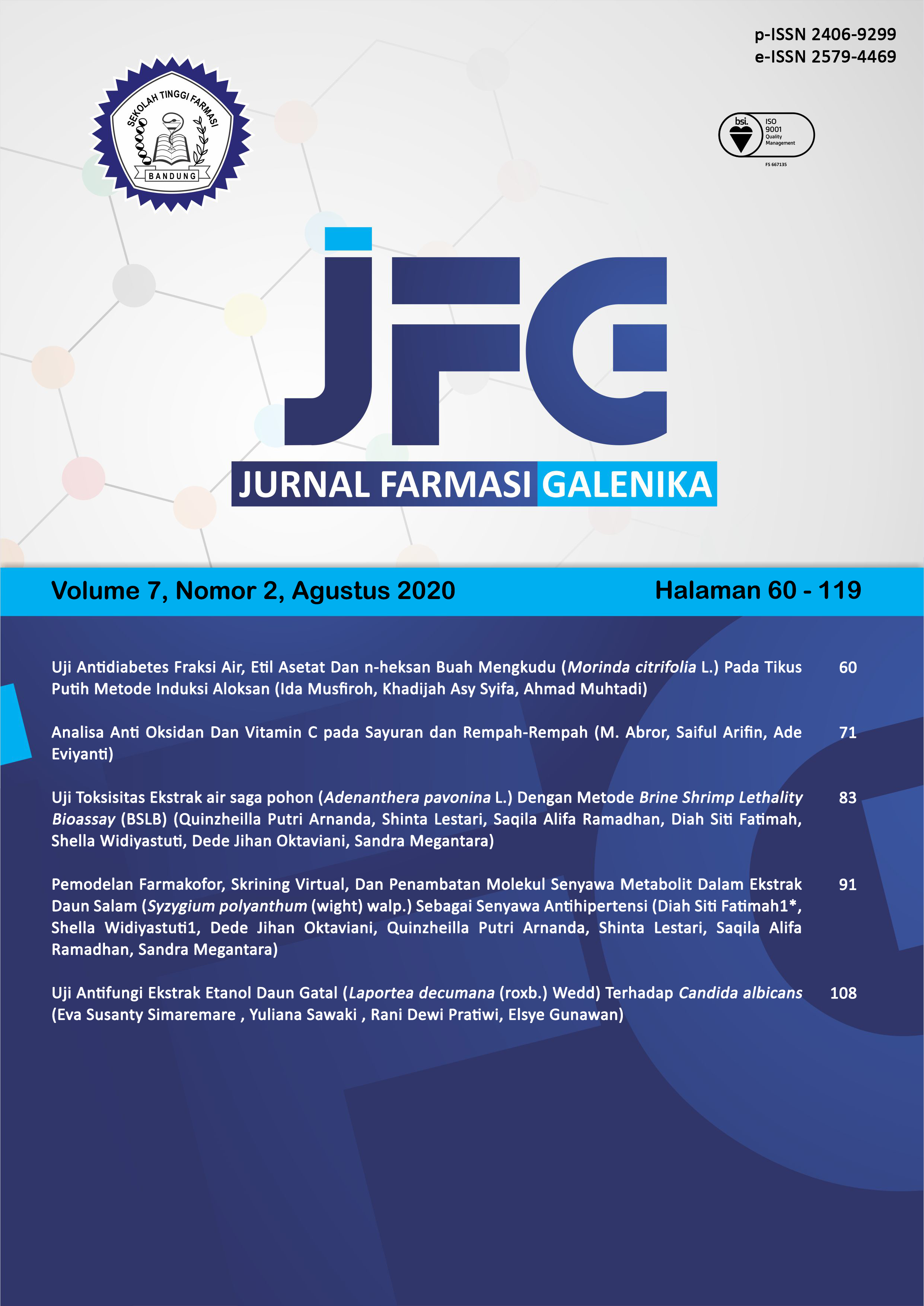UJI TOKSISITAS EKSTRAK AIR SAGA POHON (Adenanthera pavonina L.) DENGAN METODE BRINE SHRIMP LETHALITY BIOASSAY (BSLB)
DOI:
https://doi.org/10.70410/jfg.v7i2.168Abstract
Ekstrak air saga pohon (Adenanthera pavonina L.) banyak digunakan dalam pengobatan antiinflamasi dan analgesik, namun masih belum diketahui toksisitasnya. Kandungan kimia dari daun saga pohon adalah alkaloid, triterpen, sterol, asam lemak, flavonoid, dan pavonin. Penelitian ini bertujuan untuk mengetahui toksisitas ekstrak air saga pohon menggunakan metode Brine Shrimp Lethality Bioassay (BSLB) dengan konsentrasi ekstrak 15.625; 31.25; 62.5; 125; 250; 500 dan 1000 g/ml yang dilakukan terhadap larva udang (Artemia salina Leach) menggunakan teknik microwell. Diperoleh hasil yaitu tidak ditemukan kematian larva udang di berbagai konsentrasi, sehingga dapat dikatakan ekstrak air saga pohon tidak bersifat toksik dan aman digunakan untuk pengobatan reumatik dan asam urat.
Kata kunci: Adenanthera pavonina L., BSLB, LC50, toksisitas.
Downloads
References
Azmir, J., Zaidul, I.S.M., Rahman, M.M, Sharif, K.M, Mohamed, A., Sahena, F., Jahurul, M.H.A., Omar, A.K.M. 2013. Techniques for extraction of bioactive compounds from plant materials: A review. Journal of Food Engineering 117:426–436.
Ferreira, P. M. P., D. F. Farias, M. P. Viana, T. M. Souzha, I. M. Vasaconcelos, B. M. Soares, et al. 2011. Study of the Antiproliferative Potential of Seed Extracts from Northeastern Brazilian Plants. Ann. Brazilian Acad. Sci 83:1045-1058.
Global Biodiversity Information Facility. 2019. Adenanthera pavonina L. Tersedia online di https://www.gbif.org/species/2951846 [Diakses pada 8 Desember 2019].
Hamidi, ?., Jovanova, B., & Panovska, ?. 2014. Toxic?logical evaluation of the plant products using Brine Shrimp (Artemia salina L .) model. Macedonian Pharmaceutical Bulletin 60:9–18.
Husodo, T., B. Irawan, I. Wulandari, dan W. M. Dasanova. 2014. Pohon di Taman Kota Bandung. Bandung: Badan Pengelola Lingkungan Hidup di Kota Bandung.
Hyeronimus S.B. 2008. Ragam dan Khasiat Tanaman Obat. 1st ed. Jakarta: Agro Media.
Jayakumari, S., V. Ravichandiran, M. Velraj, A. K. Singh, & A. V. Lakshmi. 2012. Anti-Inflammatory Activity of Adenanthera pavonina Linn. Leaves. Journal of Natural Remedies 12:56-62.
Janakiraman, N., & Johnson, M. 2016. Ethanol extracts of selected cyathea species decreased cell viability and inhibited growth in MCF 7 cell line cultures. Journal of Acupuncture and Meridian Studies 9:151–155.
Krishnaveni, A., Selvi, S., & Mohandass, S. 2011. Antidiabetic, hypolipidemic activity of Adenanthera pavonina seeds in alloxan induced diabetic rats. Journal of Pharmacy Research 4:1440–1442.
Lim, T. K. 2012. Edible Medicinal and Non-Medicinal Plants. New York: Springer.
Lindamulage, I. K. S & P. Soysa. 2016. Evaluation of Anticancer Properties of a Decoction containing Adenanthera pavonina L. and Thespesia populnea L BMC Complement. Alternat. Med 16:1-8.
Mohammed, R. S., A. H. Abou Zeid, E. A. El-Kashoury, A. A. Sleem, & D. A. Waly. 2014. A New Flavonol Glycoside and Biological Activities of Adenanthera pavonina L. Leaves. Natural Product Research 28:282-289.
Moniruzzaman Md., Ambia Khatun, & M. Z. Imam. 2015. Evaluation of Antinociceptive Activity of Ethanol Extract of Leaves of Adenanthera pavonina. Evidence-Based Complementary and Alternative Medicine 2015:1-8.
Mujahid, M., Ansari, V., Sirbaiya, A., Kumar, R., & Usmani, A. 2016. An insight of pharmacognostic and phytopharmacology study of Adenanthera pavonina. Journal of Chemical and Pharmaceutical Research 8:586–596.
Mujahid, Md., H. H. Siddiqui, A. Hussain, & M. S. Hussain. 2013. Hepatoprotective Effects of Adenanthera Pavonina (Linn.) Against Anti-Tubercular Drugs-Induced Hepatotoxicity in Rats. Pharmacognosy Journal 5:2886-290.
Naidu, J. R., R. Ismail, & S. Sasidharan. 2014. Acute Oral Toxicity and Brine Shrimp Lethality of Methanol Extract of Mentha Spicata L (Lamiaceae). Tropical Journal of Pharmaceutical Research 13:101-107.
Sarah, Q. S., F. C. Anny, & M. Misbahuddin. 2017. Brine Shrimp Lethaly Assay. Bangladesh J. Pharmacol 2017:186-189.
Sari, R., W. Syafii, S. Achmadi, & M. Hanafi. 2011. Aktivitas Antioksidan dan Toksisitas Ekstrak Etanol Surian (Toona sinensis). Jurnal Ilmu Dan Teknologi Hasil Hutan 4:46– 52
Renilda, Sophy A. J., Albin T. Fleming, V. Rajagopal, & K. Gowri Shankar. 2016. Cytotoxicity Assessment of Adenanthera Pavonina Extracts in Brine Shrimp Larvae and Cancer Cell Lines. Inter J Vet Sci Vol 5:83-86.
Zhang, Y., J. Mu, J. Han, & X. Gu. 2012. An Improved Brine Shrimp Larvae Lethality Microwell Test Method. Toxicology Mechanisms and Methods 22:23-30.
Zuhrotun, A., A. G. Suganda, K. R. Wirasutisna, & M. S. Wibowo. 2017. Toxicity Of Selected Apocynaceae, Magnoliaceae And Simaroubaceae Of Indonesian Plants Using Brine Shrimp Lethality Bioassay. Research Journal of Pharmaceutical, Biological and Chemical Sciences 8:10-15.
Downloads
Published
How to Cite
Issue
Section
Citation Check
License
Copyright (c) 2020 JURNAL FARMASI GALENIKA

This work is licensed under a Creative Commons Attribution 4.0 International License.
Authors who publish in Jurnal Farmasi Galenika agree to the following terms:
This license enables reusers to distribute, remix, adapt, and build upon the material in any medium or format, so long as attribution is given to the creator. The license allows for commercial use. CC BY includes the following elements:
BY: credit must be given to the creator.
You are free to:
- Share — copy and redistribute the material in any medium or format for any purpose, even commercially.
- Adapt — remix, transform, and build upon the material for any purpose, even commercially.
- The licensor cannot revoke these freedoms as long as you follow the license terms.
Under the following terms:
- Attribution — You must give appropriate credit , provide a link to the license, and indicate if changes were made . You may do so in any reasonable manner, but not in any way that suggests the licensor endorses you or your use.
- No additional restrictions — You may not apply legal terms or technological measures that legally restrict others from doing anything the license permits.
Notices:
You do not have to comply with the license for elements of the material in the public domain or where your use is permitted by an applicable exception or limitation .
No warranties are given. The license may not give you all of the permissions necessary for your intended use. For example, other rights such as publicity, privacy, or moral rights may limit how you use the material.











